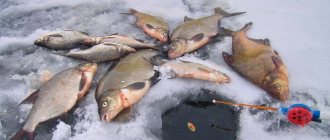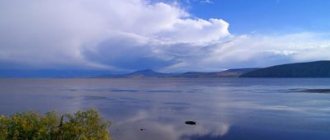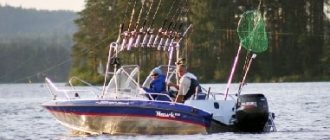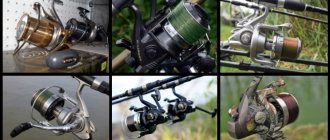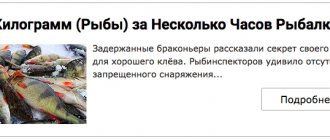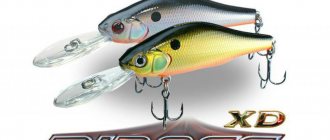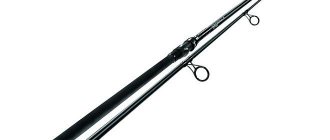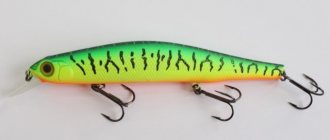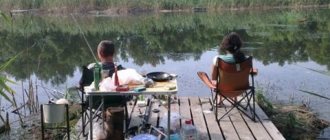HomeTourists TOP 10
You need to go to Sakhalin with a spacious suitcase. In addition to seafood delicacies and fresh caviar, you will definitely want to bring many other products and things from the island that you will not find in Moscow. Vestnik ATOR, together with the tour operator TUI, which implements the Bright Winter on Sakhalin 2019/2020 program, has compiled a top list for island shopping.
CAVIAR AND FISH
Sakhalin is the land of fish, caviar and seafood. So these delicacies are the most popular island “souvenirs”.
Sakhalin caviar is barely salted, almost raw. Most often, local residents prepare the so-called “five-minute” caviar or, as they themselves say, “homemade” caviar.
However, such a delicacy is unlikely to retain its taste until Moscow: it only needs to be stored in the freezer. Therefore, caviar that can be brought home should be bought at markets or in original packaging in stores: for the purpose of good preservation, this product is already more thoroughly salted.
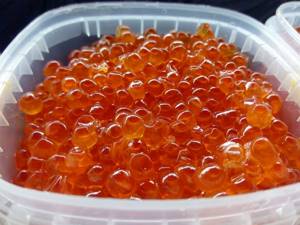
Where to buy caviar on Sakhalin? In Yuzhno-Sakhalinsk, all visitors usually buy caviar and other seafood at the “Success” market. In the covered pavilion you can find almost all the variety of seafood that is caught on the island. As local residents advise, you should definitely try salmon caviar (pink salmon, chum salmon, masu salmon, coho salmon) when you buy it at the market. However, such “service” is offered by the sellers themselves.
Prices for caviar vary, but on average a kilogram of the delicacy costs from 2800 to 3600 rubles. Caviar is most often sold in plastic jars in half-kilogram packages, so usually the price on the packaging is written for exactly this weight: 1450 rubles, 1550 rubles or 1850 rubles. Those same 50 rubles. When buying several jars of caviar or caviar and fish, sellers usually “zero out” in favor of the buyer, calling it a discount. So when buying a kilogram of caviar it will cost not 3100 rubles, but 3000 rubles.
It is recommended to buy caviar when poutine is on or immediately after. Usually the season begins in mid-summer and ends in autumn, so in winter there is caviar on Sakhalin.
As for fish, local shelves offer excellent pink salmon, coho salmon, sockeye salmon, halibut, and king salmon. Fish for every taste in the truest sense of the word: salted and not very salted, dried and smoked, soft and drier, in a classic recipe or with the addition of seasonings. You can also try fish, like caviar, at the market. When asked “which fish tastes better,” Sakhalin residents most often say smoked Chinook salmon, but at the same time they advise taking both chum salmon and sockeye salmon.

Fish, as a rule, is sold whole carcass, but there are also fillets and “balyk”. Balyk (here we mean fish with bones, but without a head) is more expensive. On average, a kilogram of fish will cost from 1500 to 2000 rubles.
There is another local specialty on Sakhalin - smelt. Unlike the fish that is so popular in St. Petersburg, Sakhalin smelt is larger. It is dried, salted, pickled. A kilogram of dried or dried Sakhalin smelt will cost from 600 to 800 rubles.
Summer fishing on the peninsula
After the rivers open up from ice, hundreds of fishermen with spinning rods appear on the banks. Lovers of Dolly Varden and Kunja go to the river rifts. It is there that you can catch specimens weighing more than 2 kilograms. Sometimes you can also find small taimen there.
Fishermen say that it is very difficult to spot fish in choppy water . Individuals very quickly capture prey as soon as they see the spoon. The fish is desperately fighting for its life and trying to free itself. At this moment, the fisherman has to act very carefully in order to pull the fish ashore.
It is known that Dolly Varden and taimen can only be caught in clean waters, so amateurs have to go to remote parts of the peninsula. Kunja is not so demanding on water quality. It can even be found in peat bogs in the tundra.
Some fishermen go to the rivers for sea rudd. It enters the rivers immediately after the ice melts. After spawning, most of the flock goes to sea, but some individuals remain in the rivers throughout the summer. When catching this species, use bottom gear with large hooks. Ugai is not considered a large fish. The average weight of an individual does not exceed 1 kilogram.
In early June, many fishing enthusiasts go to the Tym and Poronai rivers. At this time you can catch the following types of fish:
- bream,
- crucian carp,
- pike,
- taimen,
- burbot,
- Malma
It is best to catch bream at dawn or at sunset . In the evening, bream reacts very quickly to any bait. It is worth noting that with the arrival of autumn the bite becomes even better. During the period of the first frosts, the largest specimens were caught.
Fans of burbot can enjoy their favorite fish only in June. At this time, a good bite for this species is ensured. After the water in the rivers warms up, individuals try to hide well. Already at the end of July it is almost impossible to catch burbot.
Fans of flounder and greenling most often go to the bays. In the summer, fish bite on almost any bait. You can use a float rod, bottom tackle or spinning rod.
You need to start catching red fish before the mass arrival for spawning. At the beginning of August, the first schools of pink salmon and chum salmon already appear. In September it is difficult to approach the rivers due to the strong smell of rot. It is associated with the death of fish that spawn. Some fishermen saw hundreds of dead fish floating in the river. They prevent live fish from rising to the spawning ground.
HOW TO BRING FISH AND CAVAR ON A PLANE
To prevent seafood from spoiling en route, they are securely packaged right at the market in a thick layer of film and placed in thermal bags by the sellers themselves. In such professional packaging, the cold will be saved and nothing will leak in the suitcase.
Please note that if you manage to buy caviar or other delicacies somewhere on a trip around the island, for example, on the coast, where these products will be 15-20% cheaper than market ones, then you will have to take care of their reliable packaging yourself.
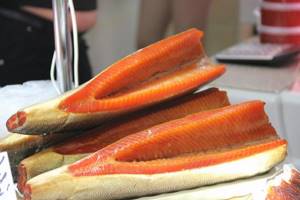
That’s why it’s worth taking adhesive tape and more bags with you to Sakhalin. Before departure, when you have to pack your suitcase, it will be problematic to buy these goods for packaging caviar or fish.
By the way, you can ask the hotel staff to “shelter” the purchased seafood delicacies before leaving home: there are often refrigerators at the reception, and local hotels know what service tourists need.
Fishing at sea - the southern part of Sakhalin Island
Tour period: May - November
Number of people in the group: 1-35 people
Duration of the tour: from 1 day or more
Fishing places: Sea of Okhotsk
What kind of fish are caught: Cod, pollock, flounder, halibut, blue perch, dogfish, stingray, crabs, octopus, squid, lakedra, masu, pink salmon, chum salmon
Sea fishing on Sakhalin is possible from May to the end of October. All this time there is an opportunity to catch more than 20 species of different fish. The fish always bite and the day when about 30 kg of fish is caught is considered a bad catch. It often happens that your hands get tired of fishing and you need time for a smoke break.

Where do we fish and on what?
We go to sea from the port of Korsakov, where you can comfortably reach from Yuzhno-Sakhalinsk in 30 minutes. For fishing, we use comfortable yachts more than 10 meters long, equipped with two stationary engines with a power of 250 hp. every. The yachts have all the conditions for comfortable sea fishing in the south of Sakhalin: toilet, basin, shower, gas stove, refrigerator, music player. For comfortable fishing, we take no more than 8 people on board each yacht. At the same time, on all our yachts we can take 35 people out fishing or for a walk on the sea.
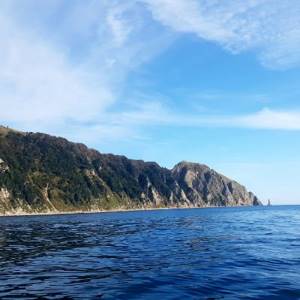
Fishing takes place off the coast of south-eastern Sakhalin, in Aniva Bay and in the area of Cape Aniva, located in the south-eastern part of Sakhalin. In addition to fishing, you will be presented with the most beautiful views of the coast of Sakhalin; you may see whales, killer whales, dolphins and seals.
What kind of fish is caught and for what purpose?
During sea fishing, you can catch flounder, pollock, cod, greenling, dogfish, stingray, blue perch, halibut and many other species of fish that live or migrate along the coast of Sakhalin. For fishing, we provide spinning rods equipped with reels, lures and bait necessary for fishing.
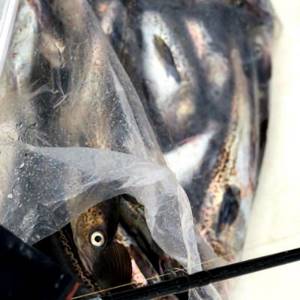
As a rule, for sea fishing we use jigs, garlands of 3-4 hooks on which a piece of fresh fish or squid is attached.
What to take with you on a fishing trip?
To ensure that sea fishing brings maximum pleasure and good mood, we recommend taking the following things with you: - windproof clothing - rain protection - cap / hat - sunglasses
Additional services:
-Special seafood menu (crabs / scallops / whelk / oysters / oriental salads / caviar) - Landing ashore for a picnic
CRABS
Crabs are popular on Sakhalin. It is better to buy fresh crabs in the shell in winter, and you should feel the phalanges: they may be empty. Most often they sell king and king crab. The last one is larger. During a trip to the coast, you can buy both the first and second types of crab, already boiled. Price - from 1,500 to 2,000 rubles. for a joke. Sellers at the market will also carefully pack crabs in a thermal bag.
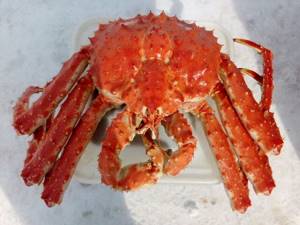
But on Sakhalin you can buy crab already cut: the cleaned meat of the phalanges is packaged in vacuum or plastic packaging without any additives. The cost differs depending on the type of crab and the phalanx itself: those that are larger are more expensive, those that are smaller are correspondingly cheaper.
A kilogram package of pure crab meat costs from 2000 rubles. – but it’s rare and cheap. On average - 3500-3700 rubles. per kg, but there is also a product priced from 5000 per kg.
OTHER SEAFOOD
From Sakhalin you can also bring seafood delicacies that are very rare for central Russia, for example, shellfish meat - whelk, octopus and squid.
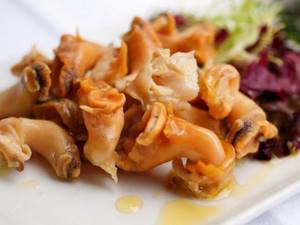
The trumpeter is known for its shells, in which the sea can be “heard” so well. Healthy trumpet meat is boiled, fried and canned. Sakhalin residents prepare Korean-style marinated snacks and salads from octopus and squid.
Another Sakhalin specialty is scallop, which is most often eaten raw on the island. They say that you can bring it too - you need to pack it in the same way as caviar. The market is also ready to pack mussels, sea urchin, oysters and shrimp for travel.
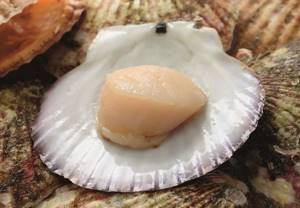
Sakhalin shrimps are very large, they are called “chilims” here. By the way, the larger and brighter the shrimp, the better its taste. But you should already carry these seafood in your hand luggage, and right in the thermal bag.
Fish of Sakhalin
Fishing in the Sakhalin Region
There are more than 270 species of fish on the southern side of the Sea of Okhotsk, and 120 on the northern side. There are about 600 species in the Sea of Japan. In addition to fish, representatives of the animal world include seals, sea lions and fur seals, 15 species of whales, of which the most famous are sperm whales, as well as dolphins and beluga whales. The inhabitants of the seabed are interesting individuals: limpets, crayfish, mussels, oysters, as well as jellyfish and stars.
Sakhalin is considered one of the largest fishing regions of our country. The main types of fish are flounder and pink salmon, herring and saury, chum salmon, pollock, cod and many others. Smelt and its variety capelin are also of great importance, and there are also gobies and rudd. In summer, Sakhalin waters are home to a large number of fish that are adapted to live in warm conditions. These include: mackerel, sardine and squid. If the summer is particularly warm, you can see exotic fish near the coast - coryphens and flying fish.
In the Sakhalin region
There are many small mountain rivers flowing through it. They contain mainly algae, pearls, bloodworms, etc. Among the fish there are representatives of salmon, such as pink salmon, char, chum salmon, and taimen. They come here during spawning. At the very bottom, crayfish and mollusks made their home.
Fans and connoisseurs of the fish world know one indisputable truth. It lies in the fact that the words are inseparable - Sakhalin, red fish. The red fish family of Sakhalin is represented by freshwater and anadromous fish: salmon, pink salmon and chum salmon, which are well known to everyone. Not far behind them are sockeye salmon, coho salmon, char, taimen, pink salmon and various other fish (Sakhalin is very rich in this regard). Most representatives of salmon are industrial fish. They consider not only meat valuable, but also red caviar. Here is a brief description of some of them:
Pink salmon
. This is the most common coastal fish in the fishery. When pink salmon are at sea, they have a silvery color, and small dark spots are visible on the tail. In the river it’s completely different. Dark spots are located on the back, sides and head. Closer to spawning, the body becomes brown, the belly remains white, and the fins and head become black. Males have an interesting hump on their back, which is why the fish is called “pink salmon.” Teeth grow on crooked jaws.
Pink salmon meat tastes great, and the nutritional value is no worse than other salmon, except that the fat content is a little less. Regular consumption of fish helps maintain a normal balance of minerals and nutrients. Vitamin PP, which is included in pink salmon in large quantities, helps maintain normal metabolism and helps the nervous system function.
Kichuzh
. A large fish, weighs about 15 kg and is one meter long. It is often called “silver salmon” because of its silvery scales. In our country, coho salmon is known as “white fish”.
Coho salmon has incredibly tasty red meat, juicy, aromatic and tender. It is used to prepare delicious dishes in restaurants and make kebabs. Meat is valuable for the presence of vitamins, trace elements and minerals.
Chum salmon
. Migratory fish up to one meter long. Weighs 15-16 kg. It spends almost its entire life in sea waters, and enters rivers to spawn, which happens once in a lifetime. On the way back the chum salmon dies. In the sea it has a silver color, in the river it darkens just before spawning and its teeth enlarge.
Chum salmon meat differs from other salmon in its bright color and amazing specific taste. The main thing is to skillfully cook this exotic fish. But first of all, the value of chum salmon lies in the largest orange-red caviar.
Red salmon
. Found in eastern Sakhalin. This is a fish of the salmon family, its other name is red. The body shape and size are identical to chum salmon, the only difference being the number of gill rakers. Chum salmon has 18 of them, and sockeye salmon has 30 or more.
This fish is valued for a very important component of meat - phosphoric acid, which controls chemical reactions in the cells of the human body.
TO SAKHALIN – WITH A TOUR OPERATOR
You can go on a tour to Sakhalin this winter with the tour operator TUI Russia. The TUI Russia winter program in Sakhalin with skiing on the slopes of the Mountain Air sports complex and accommodation in the best hotels in the city is available for booking.
The cost of a week-long tour without flights starts from 10.5 thousand rubles. per person with unlimited ski pass.
You can find out more about TUI's winter offers in Sakhalin on the tour operator's website.
